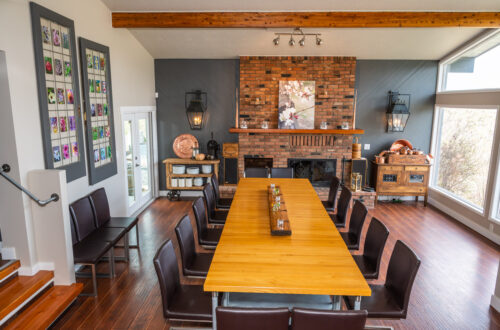What is the First-Time Home Buyer Incentive?
On September 2, 2019 the Canada Mortgage and Housing Corporation launched the First-Time Home Buyer Incentive (“FTHBI”), with the aim of helping first-time homebuyers reduce their monthly mortgage payments without increasing their down payments.
To be eligible, a first-time homebuyer must have: 1) a minimum down payment of 5 per cent from traditional sources such as savings and RRSPs; 2) a maximum qualifying annual income of no more than $120,000; and 3) a loan amount of no more than 4 times a borrower’s qualifying annual income.
Using these criteria, we examine the potential uptake of the FTHBI in select regions in B.C., broadly representing the province’s 11 real estate boards.
What share of households would be eligible under the $120,000 maximum income threshold?
To be eligible for the FTHBI, first-time homebuyers may have a maximum qualifying annual income of no more than $120,0001. Using a Census 2016 custom tabulation from Statistics Canada on household annual income by age and tenure, we specify first-time homebuyers as renter households between the ages of 25 and 39; this represents the prime home buying age cohort. The data show that more than 65 per cent of first-time homebuyers in each select region would be eligible under the FTHBI’s maximum income threshold, with the lowest share in North Vancouver (66 per cent) and the highest in Penticton (86 per cent). Overall, the share of first-time homebuyers that meet the income criteria is relatively comparable across most regions.
What share of available homes would fall within the FTHBI eligibility criteria?
Using the FTHBI eligibility criteria, we calculate the maximum house price to be $505,2632, assuming a minimum down payment of 5 per cent3 and a maximum qualifying annual income of $120,000.
Using provincial assessment data on 2018 home sales, we find that the lowest shares of homes that would qualify are in North Vancouver (13 per cent) and the City of Vancouver (20 per cent). These regions combined made up 13 per cent of provincial sales in 2018. In contrast, the highest shares of homes that would qualify are in Dawson Creek (97 per cent) and Prince George (91 per cent), making up a combined share of 2 per cent of provincial sales.
The share differences in these select regions are reflective of house prices. For example, the average house price in North Vancouver ($1,092,969) is more than four times higher than in Dawson Creek ($250,348).
What does this mean in terms of the potential uptake of the FTHBI?
The highest potential uptake of the FTHBI would be in more affordable regions located outside of the Lower Mainland, which comprised 20 per cent of provincial sales in 2018. In contrast, the regions with the lowest potential uptake would be in the Lower Mainland4 and Victoria, which comprised 44 per cent of provincial sales5. This suggests that the FTHBI is expected to have limited impact on provincial home sales.
The potential uptake of the FTHBI is not particularly reliant on the income criteria because the share of first-time homebuyers exceeding the maximum income threshold are relatively comparable across the regions.
Unsurprisingly, the differences in the potential uptake of the FTHBI across the select regions is largely explained by the allowable maximum house price. As such, the price threshold is the most limiting in regions with higher house prices, which tends to be concentrated in the Lower Mainland and Victoria.
Appendix: Proposed Changes to the First Time Homebuyer Incentive
The Liberal Party announced on September 12 that if re-elected, it would expand the FTHBI in Toronto, Vancouver and Victoria. The expansion would increase the maximum qualifying annual income from $120,000 to $150,000 and increase the leverage factor from 4 times the maximum qualifying annual income to 5 times.
With a minimum down payment of 5 per cent and a maximum qualifying annual income of $150,000, these changes would increase the maximum house price from $505,263 to $789,4746. The impact would be most noticeable in the share of homes that would be eligible under the FTHBI. In the Lower Mainland, the share of eligible homes would increase from an average of 28 per cent to 62 per cent, and from 49 per cent to 78 per cent in Victoria.
Notes and References:
1. This is subject to qualifying income requirements set out by the mortgage lender and mortgage loan insurer. Examples of qualifying annual income include a salary before taxes and investment income.
2. Calculated as 4 times the maximum qualifying annual income of $120,000 divided by the fraction of the borrower’s minimum down payment of 5 per cent (i.e., 1-0.05).
3. A potential first-time homebuyer could put down up to a maximum of 14.99 per cent, which would then put the maximum house price at $565,000. A maximum of 14.99 per cent plus 5 per cent equity from the Government of Canada would place the borrower just under the 20 per cent threshold to qualify for an insured mortgage.
4. Lower Mainland includes Burnaby, Coquitlam, Langley, New Westminster, North Vancouver, Richmond, Surrey and Vancouver City.
5. The shares quoted here do not add up to 100 per cent because we only include select regions in B.C. 6. Changing the income threshold has no impact on the share of eligible first-time homebuyers, except for a minimal impact in Vancouver (increase of 1 per cent).
courtesy: https://www.bcrea.bc.ca




